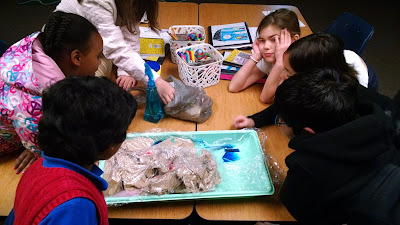We used some of these websites as a fun follow-up to our lesson. Students wanting more practice can enjoy exploring them more at home!
Interpreting Data
Data Bank Research
We also read the first chapters of Listening to Crickets, our novel study about environmentalist Rachel Carson. We are learning from her example and identifying Habits of Mind that Rachel used to find success in her field.
We didn't neglect our Gray Area investigation. Students role-played a reenactment of a meeting of the Gray Area Board of Supervisors where our suspect and owner of the water slide was consulted and shared results from chlorine tests conducted down the river from the water slide. We also reflected on our last time together and compared a river to the report card of it's watershed. Next week, students will take a closer look at the results, perform a bio-assessment of their own, and examine some secret documents that may provide further clues.
We also read the first chapters of Listening to Crickets, our novel study about environmentalist Rachel Carson. We are learning from her example and identifying Habits of Mind that Rachel used to find success in her field.
Student Reflection:
So far Rachel has used persisting, gathering data through all senses, and thinking flexibly. She used persisting during the Great Depression when she always had a job. She gathered data through all her senses by listening to nature, staying still, and listening to her mom. She thinked flexibly by writing different stories. This is what I would say for character traits and habits.













